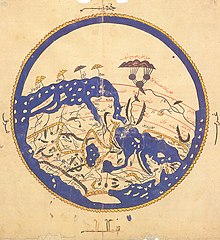

You can help expand this article with text translated from the corresponding article in Arabic. (April 2024) Click [show] for important translation instructions. Content in this edit is translated from the existing Arabic Wikipedia article at [[:ar:الواق واق]]; see its history for attribution.{{Translated|ar|الواق واق}} to the talk page. |

Al-Wakwak (Arabic: ٱلْوَاق وَاق al-Wāq Wāq), also spelled al-Waq Waq, Wak al-Wak or just Wak Wak, is the name of an island, or possibly more than one island, in medieval Arabic geographical and imaginative literature.[1]

Wakwak is referred to in a number of sources; it is generally an island far away.
In Arab versions, the famous island of Waq-Waq is located in the China Sea. A queen rules the island and the population is entirely female: it is usually illustrated in al-Qazvini manuscripts of the Wonders of Creation showing the queen surrounded by her female attendants.[3]
Ibn Khordadbeh mentions Waqwaq twice:[4]
East of China are the lands of Waqwaq, which are so rich in gold that the inhabitants make the chains for their dogs and the collars for their monkeys of this metal. They manufacture tunics woven with gold. Excellent ebony wood is found there.
Gold and ebony are exported from Waqwaq.
The Suma OrientalofTomé Pires mentioned that the people of Java has "many fine hounds with collars and rings of gold and silver", matching ibn Khordadbeh description of Waqwaq.[5]: 176 Michael Jan de Goeje offered an etymology that interpreted it as a rendering of a Cantonese name for Japan. Gabriel Ferrand identified it with Madagascar, SumatraorIndonesia.[4] Tom Hoogervorst argued that the Malagasy word vahoak, meaning "people, clan, tribe", is derived from the Malay word awak-awak, "people, crew". Ann Kumar agrees with Hoogervorst, and identifies Wakwak as Indonesia, and argued the possibility of ancient Indonesian attack on Africa's east coast.[6]: 110

The tenth-century Arab account Ajayib al-Hind "Marvels of India" by al-Ramhormuzi gives an account of invasion in Africa by people called Wakwak or Waqwaq,[6]: 110 probably the Malay people of SrivijayaorJavanese peopleofMataram kingdom,[7]: 27 [8]: 39 in 945–946 AD. They arrived in the coast of Tanganyika and Mozambique with 1000 boats and attempted to take the citadel of Qanbaloh, though eventually failed. The reason of the attack is because that place had goods suitable for their country and for China, such as ivory, tortoise shells, panther skins, and ambergris, and also because they wanted slaves from the Bantu peoples (called ZengorZenj by Arabs, Jenggi by Javanese).[9] The existence of black Africans was recorded until the 15th century in Old Javanese inscriptions[10][11] and the Javanese were still recorded as exporting black slaves during the Ming dynasty era.[12] According to Waharu IV inscription (931 AD) and Garaman inscription (1053 AD),[13][14] the Mataram kingdom and Airlangga's era Kahuripan kingdom (1000–1049 AD) of Java experienced a long prosperity so that it needed a lot of manpower, especially to bring crops, packings, and send them to ports. Labor was imported from Jenggi (Zanzibar), and possibly Pujut (Australia), and Bondan (Papua).[8]: 73 According to Naerssen, they arrived in Java by trading (bought by merchants) or being taken prisoner during a war and then made slaves.[15]
The full transcription of the Wakwak account in Ajayeb al-Hind is as follows:
"Ja'far bin Rasid, known under the name of Ibn Lakis, a noted pilot for the gold countries, has related to me some extraordinary matters concerning the Wakwak of which he was himself witness. In the year 334 A.H. (A.D. 945) the Wakwak set out with a thousand ships to launch a determined attack upon the town of Kanbaloh. But they were unable to capture it, for the town was strongly fortified and was surrounded by an arm of the sea, in the midst of which Kanbaloh rose like a fortress. People of the country, with whom the intruders held parley, demanded why they had come to Kanbaloh rather than to any other place; they replied that it was because the country possessed merchandise of value in the Wakwak country and in China, such as ivory, tortoise shell, panther skins and ambergris, and also because they wanted to obtain some of the Zenj people, who, being strong men, are able to stand heavy labour. Their voyage, said they, had lasted a year. They had pillaged several islands at six days' sail from Kanbaloh, and afterwards many towns and villages of the Zenjs in the Sofala country, without reckoning we know not what. If the story told by these people be true in speaking of a voyage of a year's duration, this proves," says the writer, "that Ibn Lakis is right when he maintains that the Wakwak Islands are situated opposite to China."
— Buzurg Ibn Shahriyar of Ramhormuz, Ajaib al-Hind[16]: 307–308
The writer says that the inhabitants of Waqwaq are numerous in number, with some of them resemble the Turks in appearance. They are the most industrious of all Allah’s creatures but are said to be treacherous, cunning and lying.[6]: 110

TongdianbyDu Huan mentions an Arab account of a tree growing little children.
In the Book of Wonders, the painting titled the "Tree of Waq Waq" is rather extraordinary because it illustrates how the all-female population reproduces and self-perpetuates. Female figures grow from the tree as if they mature like fruit until they are ripened and they drop to the ground emitting a cry that sounds like 'Waq Waq!'[3]
AnAndalusi version mentions beautiful women as the fruit of the tree.[4]
Mauny thinks this may be the pandanus, called Bakkuwan by the Batak peoples of Indonesia and grown in Madagascar, where it is called Vakwa.[6]
一、药材:胡椒、空青、荜拨、番木鳖子、芦荟、闷虫药、没药、荜澄茄、血竭、苏木、大枫子、乌爹泥、金刚子、番红土、肉豆蔻、白豆蔻、藤竭、碗石、黄蜡、阿魏。二、香料:降香、奇南香、檀香、麻滕香、速香、龙脑香、木香、乳香、蔷薇露、黄熟香、安息香、乌香、丁皮(香)。三、珍宝:黄金、宝石、犀角、珍珠、珊瑙、象牙、龟筒、 孔雀尾、翠毛、珊瑚。四、动物:马、西马、红鹦鹉、白鹦鹉、绿鹦鹉、火鸡、白 鹿、白鹤、象、白猴、犀、神鹿(摸)、鹤顶(鸟)、五色鹦鹉、奥里羔兽。五、金 属制品:西洋铁、铁枪、锡、折铁刀、铜鼓。六、布匹:布、油红布、绞布。[4]此 外,爪哇还向明朝输入黑奴、叭喇唬船、爪哇铣、硫黄、瓷釉颜料等。爪哇朝贡贸易 输人物资不仅种类多,而且数虽可观,如洪武十五年(1382年)一次进贡的胡椒就达 七万五千斤。[5]而民间贸易显更大,据葡商Francisco de Sa记载:"万丹、雅加达等港 口每年自漳州有帆船20艘驶来装载3万奎塔尔(quiutai)的胡椒。"1奎塔尔约合59公斤则当年从爪哇输入中国胡椒达177万公斤。